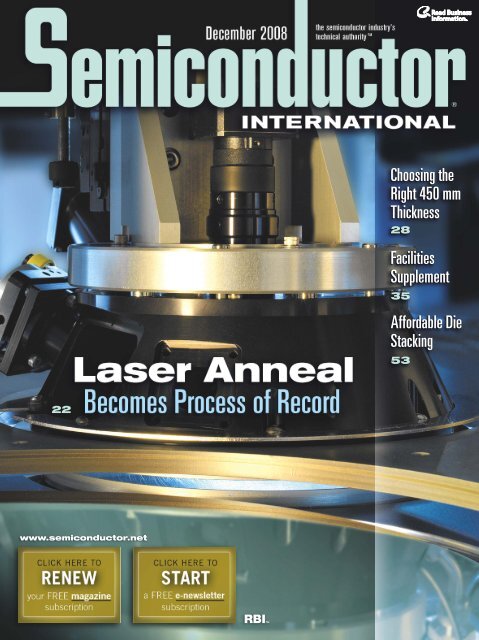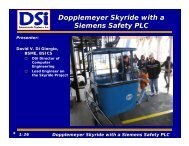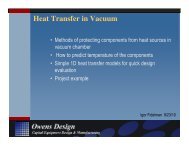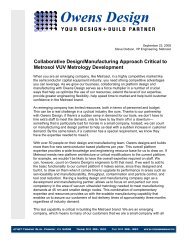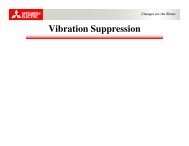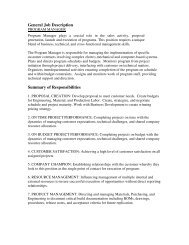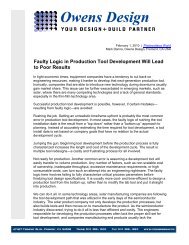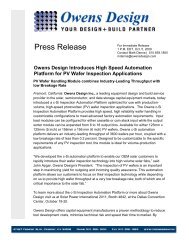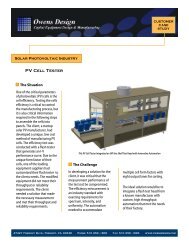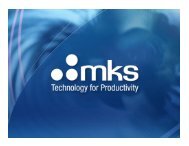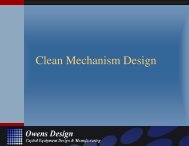Decoupling Platform and Tool Development - Owens Design
Decoupling Platform and Tool Development - Owens Design
Decoupling Platform and Tool Development - Owens Design
Create successful ePaper yourself
Turn your PDF publications into a flip-book with our unique Google optimized e-Paper software.
Choosing the<br />
Right 450 mm<br />
Thickness<br />
28<br />
Facilities<br />
Supplement<br />
35<br />
Affordable Die<br />
Stacking<br />
53<br />
22<br />
www.semiconductor.net
<strong>Decoupling</strong> <strong>Platform</strong><br />
Collaborative development between OEMs <strong>and</strong> platform specialists can<br />
reduce internal R&D funding resources while speeding new equipment time-to-market.<br />
The semiconductor industry faces a growing challenge<br />
in keeping up with the high pace of IC development<br />
m<strong>and</strong>ated by the International Technology Roadmap for<br />
Semiconductors (ITRS) <strong>and</strong> Moore’s Law. While there<br />
is little doubt that the industry can continue to push<br />
critical dimensions to even lower design nodes, there’s a growing<br />
concern on how long transistor costs will keep on dropping. Each<br />
new design node <strong>and</strong> wafer size is becoming increasingly costly to<br />
implement, <strong>and</strong> such costs are falling more heavily on the equipment<br />
manufacturers.<br />
In part, these rising costs are driven by what can be characterized<br />
as a “cottage industry” approach to tool development. By <strong>and</strong> large,<br />
each semiconductor OEM, whether start-up or established manufacturer,<br />
expends a considerable portion of its R&D dollars to development<br />
of equipment platforms rather than core technologies.<br />
Often the greatest stumbling blocks to bringing the next-generation<br />
technology to market involve not only critical improvements<br />
in tool process capability, but also required improvements in tool<br />
platform performance.<br />
This article describes a paradigm shift in the way semiconductor<br />
tool development <strong>and</strong> manufacture is conducted. It focuses on collaborative<br />
innovation <strong>and</strong> leveraging economies of scale to enable<br />
OEMs to lower tool development costs, while enhancing their<br />
ability to reduce the time required to bring production-worthy<br />
tools to market.<br />
Growing R&D crisis<br />
For more than 40 years, the semiconductor industry has experienced<br />
significant <strong>and</strong> relatively steady growth by relentlessly following<br />
the “faster, smaller, cheaper” dictum that is at the heart of Moore’s<br />
Law. Today, as we approach the 45 nm node, this steady pace of<br />
growth <strong>and</strong> innovation is being threatened as the industry pushes<br />
the boundaries of key scientific disciplines such physics, chemistry<br />
<strong>and</strong> materials science. Not only is it becoming scientifically more<br />
challenging, but a gap has emerged between the pace of innovation<br />
required by Moore’s Law <strong>and</strong> the cost of funding that innovation.<br />
Industry analyst Ron Leckie has estimated that R&D funding<br />
required by the semiconductor equipment <strong>and</strong> materials industry<br />
by 2010 for continued scaling will reach $16.2B — a figure that<br />
could swell to $19.7B if the industry transitions to 450 mm wafers.<br />
Unfortunately, as shown in the Figure, the industry’s projected<br />
R&D budget for 2010 is only $10.4B, leaving a potential funding<br />
gap of $9.3B just two years from now. 1<br />
This situation is exacerbated by changing industry dynamics.<br />
Traditionally, the semiconductor equipment industry revenue<br />
growth has been faster than that of the device sector, but is now<br />
approximately equal. Between 1981 <strong>and</strong> 2005, semiconductor<br />
revenue growth slowed from 17 to 7%, while equipment revenue<br />
growth slowed from 20 to 5%. 2 As was seen with the 300 mm<br />
transition, however, the equipment industry is now being expected<br />
by its customers to carry an ever growing share of the R&D burden<br />
required to develop the new tools. This has forced the industry<br />
to continue investing in R&D at an unsustainable rate, creating<br />
a problem that is not limited to small companies. Speaking to<br />
Electronic News (April 1, 2005), Applied Materials’ CEO Mike<br />
Splinter stated, “R&D spending averages between 15% <strong>and</strong> 18%<br />
overall, but there’s hardly ever an average year. It’s difficult for us<br />
<strong>and</strong> our competitors to fit in all that’s required. I believe there is an<br />
R&D crisis in the equipment industry.”<br />
Cottage industry approach<br />
Ten to 15 years ago, competition among semiconductor equipment<br />
manufacturers was framed in terms of throughput, process reliability,<br />
repeatability <strong>and</strong> innovation. Although all of these factors<br />
remain important, tool cost of ownership (CoO) has become an<br />
increasingly important competitive advantage. Device manufacturers<br />
are pressuring equipment companies to provide the latest process<br />
technology at ever lower costs, yet equipment companies require<br />
adequate revenues to support the R&D needed to develop new<br />
processes. Clearly, what is needed is an effective means of lowering<br />
the cost of developing <strong>and</strong> deploying new process technology.<br />
The semiconductor equipment industry is, of course, not the<br />
only industry to have encountered this kind of R&D challenge.<br />
About seven years ago, Proctor & Gamble was experiencing a<br />
similar crisis. The company realized that its old business model,<br />
in which all R&D was conducted internally, would not support<br />
the product development required to meet future revenue growth<br />
targets. It found that there were at least 200 researchers doing similar<br />
work for every researcher employed internally. The company<br />
decided to change its development strategy <strong>and</strong> tap into these outside<br />
resources. Today, 35% of the company’s new ideas come from<br />
outside consultants, R&D productivity is up ~60% <strong>and</strong> R&D cost<br />
as a percentage of revenue is down. 3<br />
R&D spending by semiconductor equipment companies is<br />
4-6× higher than in any other manufacturing sector. 4 Although<br />
the industry has successfully squeezed the waste out of most other<br />
operational functions, R&D is one of the last key controllable expenses<br />
that the industry has yet to optimize. Certainly, the industry<br />
has made some efforts in this direction, such as the formation of<br />
consortia <strong>and</strong> alliances such as Sematech (Austin, Texas). Although<br />
this has helped to slow the R&D growth rate, 5 it has not proven to<br />
be the complete answer to the problem.<br />
It is estimated, for example, that as much as 80% of the work that<br />
equipment engineers perform is not directly related to development<br />
of core technology. 6 Some of these tasks include generic platform<br />
design, translating prototypes to production, upgrading mature<br />
products, qualifying vendors, quality testing, documentation <strong>and</strong><br />
manuals — many of which could be easily <strong>and</strong> effectively outsourced.<br />
Performing these tasks takes away time that could <strong>and</strong> should be<br />
devoted to the key reason for R&D investment: to develop the nextgeneration<br />
technology needed to keep the company competitive.<br />
This generalist, or cottage industry, approach to new tool develop-<br />
32 SEMICONDUCTOR International December 2008 www.semiconductor.net
& <strong>Tool</strong> <strong>Development</strong><br />
for Lower CoO<br />
Mark Danna, <strong>Owens</strong> <strong>Design</strong> Inc.,<br />
Fremont, Calif., www.owensdesign.com<br />
ment not only makes less than efficient<br />
use of the tool development engineer’s<br />
valuable time, it also requires a higher<br />
level of staffing than would otherwise be<br />
required, which drives up costs. It has a<br />
further downside in what is a very cyclical<br />
industry: layoffs during down cycles,<br />
followed by hiring binges during up cycles.<br />
These cycles are hard on employee<br />
morale <strong>and</strong> frequently leave equipment<br />
companies scrambling to meet customer<br />
dem<strong>and</strong>s during upturns.<br />
More efficient development<br />
Collaborative development, an emerging<br />
tool development approach, offers<br />
semiconductor equipment companies<br />
an opportunity to reduce their tool<br />
development costs, minimize technical<br />
risk, optimize platform performance<br />
<strong>and</strong> speed time to market. It also focuses<br />
the OEM’s internal resources on core<br />
technology improvement. The OEM works closely with an outside<br />
design <strong>and</strong> manufacturing company that is an expert in semiconductor<br />
platform development. The OEM is responsible for the<br />
core technology; the outsource platform design <strong>and</strong> manufacturing<br />
company is responsible for integrating this new core technology<br />
onto a generic equipment platform. The OEM provides the outsource<br />
company with its desired platform performance specifications<br />
concerning footprint, particle <strong>and</strong> contamination, electrical<br />
<strong>and</strong> controls architecture, software architecture, factory interface<br />
<strong>and</strong> general tool construction.<br />
The platform design company optimizes all of these subsystems<br />
<strong>and</strong> ensures that they will integrate correctly with the process hardware<br />
developed by the OEM. It also focuses on resolving key platform<br />
issues such as maintainability, serviceability <strong>and</strong> manufacturability,<br />
while the process engineers resolve key process challenges.<br />
The platform design house has several significant advantages that<br />
enable it to perform these tasks much more effectively <strong>and</strong> costefficiently<br />
than the OEM. These include engineering experience,<br />
methodology <strong>and</strong> partnerships.<br />
The average OEM will typically design a new platform every three<br />
to four years, while a platform design house will design five to seven<br />
platforms a year. This higher level of platform design activity allows<br />
the design house to streamline the platform development process. Its<br />
engineering <strong>and</strong> manufacturing teams have developed proven tools<br />
that are optimized for performance <strong>and</strong> manufacturability, resulting<br />
in accelerated time-to-market. <strong>Platform</strong> design houses also have close<br />
partnerships with subsystem manufacturers, such as the developers<br />
of factory-level automation software. As a result, they are very aware<br />
of the available subsystem options <strong>and</strong> can more quickly determine<br />
R&D funding<br />
2000<br />
R&D Funding Gap<br />
Dem<strong>and</strong><br />
Supply<br />
$19.7B<br />
$10.4B<br />
2005 2010<br />
1. The projected R&D budget for equipment <strong>and</strong> materials<br />
suppliers falls >$9B short of what is expected to<br />
be required to stay on the technology curve. (Source: Ron<br />
Leckie, Infrastructure Advisors)<br />
which are best suited for a particular<br />
platform’s requirements.<br />
For this collaborative approach to<br />
succeed, it’s critical for both the platform<br />
engineering design company <strong>and</strong><br />
the OEM to take a long-term strategic<br />
approach. To be effective, collaborative<br />
development must be addressed from<br />
a company or product roadmap perspective.<br />
Decisions must be made to<br />
determine which areas will be focused<br />
on by the OEM’s engineers <strong>and</strong> which<br />
will be focused on by the design partner.<br />
It’s necessary to determine which<br />
additional technologies <strong>and</strong> skill sets<br />
will be required <strong>and</strong> who will be tasked<br />
with providing them.<br />
In addition to speeding the time<br />
to market for new process tools, an<br />
established OEM can use this approach<br />
to reduce the CoO of existing<br />
process tools, while adding new<br />
platform functionality. Working with an OEM on the redesign<br />
of an existing platform, we were able to reduce the cost of one<br />
tool platform by 30%, while simultaneously helping to integrate<br />
improvements in process technology.<br />
Conclusion<br />
The rising cost of process technology development, coupled with<br />
tight margins, is making it more <strong>and</strong> more challenging for semiconductor<br />
equipment companies to rapidly <strong>and</strong> cost-effectively develop<br />
the technology needed to meet the continuing innovation dem<strong>and</strong>ed<br />
by Moore’s Law. Traditionally, process tool manufacturers have expended<br />
a considerable portion of their R&D dollars <strong>and</strong> engineering<br />
time on platform <strong>and</strong> process development. Partnering with an engineering<br />
design house to collaboratively develop new tool platforms<br />
can help speed time-to-market <strong>and</strong> reduce overall system costs. SI<br />
References<br />
1. R. Leckie, “Semiconductor Equipment <strong>and</strong> Materials: Funding the Future,”<br />
SEMI white paper, October 2005.<br />
2. R. Leckie, “Funding the Future,” ISS Conference Presentation, February 2006.<br />
3. L. Huston <strong>and</strong> N. Sakkab, “Connect <strong>and</strong> Develop,” Harvard Business Review,<br />
March 2006, p. 58.<br />
4. R. Rubbico, T. Bowe, N. Delisle <strong>and</strong> H. Lougee, “Drive Top-Line Growth in the<br />
Consolidating Semiconductor Market,” Foliage white paper.<br />
5. G.D. Hutcheson, “The R&D Crisis,” VLSI Research white paper.<br />
6. M. Kripalani, A. Reinhardt, B. Nussbaum <strong>and</strong> P. Burrows, “Outsourcing Innovation,”<br />
Business Week, March 21, 2005, p. 86.<br />
Mark Danna received a B.A. in marketing from the University of Utah<br />
(Salt Lake City) <strong>and</strong> a B.S. in mechanical engineering from the University<br />
of Santa Clara. He has also completed graduate studies in advanced<br />
dynamics <strong>and</strong> controls at the University of California, Santa Barbara. He<br />
is senior director of business development at <strong>Owens</strong> <strong>Design</strong> Inc.<br />
Email: mdanna@owensdesign.com<br />
www.semiconductor.net December 2008 SEMICONDUCTOR International<br />
33


